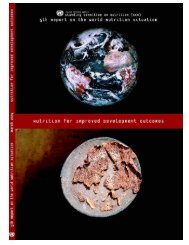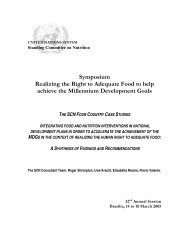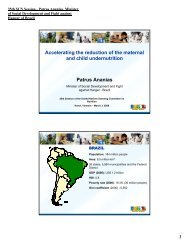Universal Salt Iodization (USI) - FTP Directory Listing
Universal Salt Iodization (USI) - FTP Directory Listing
Universal Salt Iodization (USI) - FTP Directory Listing
- No tags were found...
Create successful ePaper yourself
Turn your PDF publications into a flip-book with our unique Google optimized e-Paper software.
34FEATURESmajor intervention in the whole of China. Through its communications efforts, the National Health Educationand Promotion Program and IDD Day play an important role for social mobilization and promotion of theconsumption of iodized salt. The Ministry of Health (MOH) and the <strong>Salt</strong> Industry formulated a NationalMonitoring Plan on <strong>USI</strong> and evaluation of iodine nutritional status in the population.Improvement of salt production facilities and expanded availability of adequately iodized saltThere were two major issues to be addressed while implementing the <strong>USI</strong> programme nationwide. First,enhancing the total annual production of iodized salt to meet the need for total consumption and, second,technical assistance was required to upgrade the production facilities in order to guarantee the quality ofiodized salt. To accomplish this, the State Council set up a special “Fund for the <strong>USI</strong> Project”. Theimplementation and enforcement of the project played an extremely important role in the promotion of edibleiodized salt in China. The total investment for the project amounted to 1 billion RMB (US$ 125 million), ofwhich the World Bank was able to fast track a loan totalling 27 million US$ in 1995 (Yip et al 2004). Thesuccess of the project greatly enhanced the production capacity of iodized salt to a yearly total output of 8million tons of iodized salt (Chen 2006), which could meet the needs of the <strong>USI</strong> programme nationwide(Figure 1). Meanwhile, the investment also supported the upgrading of salt production facilities usingadvanced technology and equipment, helped promote a tremendous scientific and technologicaladvancement in the Chinese <strong>Salt</strong> Industry as a whole.Legislation and monopolyThe State Council (the highest national policy making body) made a historical key decision to assure that alledible salt is properly iodized and to reverse the process toward the free market approach from 1980onwards. In support of this decision, the Chinese Government promulgated “Iodized <strong>Salt</strong> ManagementRegulation for Control of IDD in China” and “Edible <strong>Salt</strong> Monopoly Regulation”. Following this, 34 local lawsor regulations were formulated and enforced in each province in order to supply acceptable iodized salt andto prevent illegal salt from entering the market. This policy facilitated centralization of the salt industry and thecontinuation of a centrally planned system, rather than a free market mechanism, for the management of saltproduction and distribution.A nationwide sales framework with a regulated salt market for the wholesaling and retailing of iodized saltwas set up and continuously strengthened to assure edible salt iodization and distribution. Based on thepolicy, legislation and reform plan for the salt industry, a total of 108 larger salt producers were licensed toproduce iodized salt only for human consumption. More than 6,000 licenses were issued for edible saltwholesaling by concerned companies, and 140,000 sets of licenses for edible salt transportation were issuedevery year. There is a strong ban on the production, transportation and sale of salt by any producers or saltwholesalers without legal licenses. The network adopted a modern system for logistics and distributionmanagement, and helped to increase the popularity of edible iodized salt. The China National <strong>Salt</strong> IndustryCompany (CNSIC) defines the production quota for each salt plant and allocates geographic areas for saltdistribution. The centralization of iodized salt production and distribution has resulted in very high coverage ofiodized salt (Table 1) in all areas (except the most remote areas) and the centrally planned mechanism isable to effectively prevent non-iodized salt from entering the market.Practical measures against illegal trade of non-iodized saltCNSIC and <strong>Salt</strong> Industry Administrations at different levels have the authority to act as so called “salt police”to eliminate the trading of non-iodized salt at the production, transport or retailing levels. Non-iodized saltleakage is a long-term problem for the implementation of <strong>USI</strong> in some coastal provinces since there are manysmall salt plants owed by private interests or local government. A successful model to solve this problem hasbeen implemented. The Provincial Governments made a decision to close down the small salt plantsproducing the illegal non-iodized salt and at same time the salt authorities and local governments provided aspecial fund to help these producers to start alternate lines of business in the former salt fields for ensuringtheir income such as fish or shrimp farming. This successful “closing/conversion” model now plays a valuableSCN NEWS # 35 back to contentswww.unsystem.org/scn







